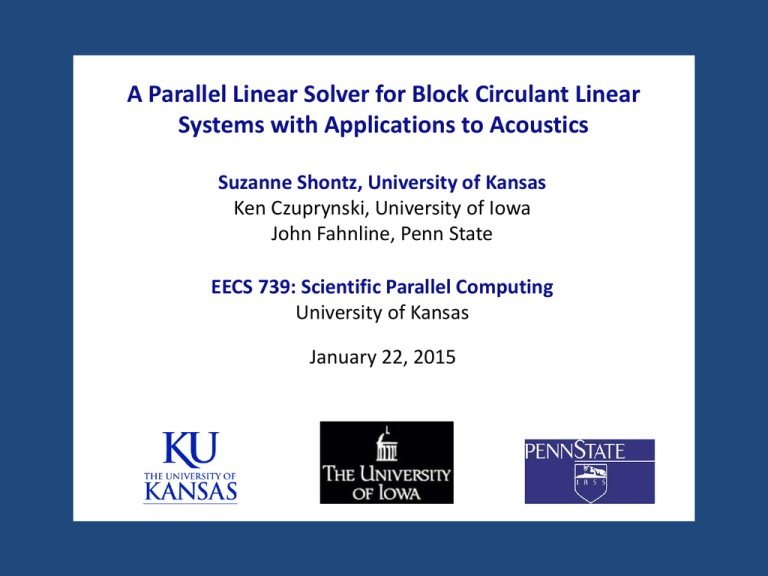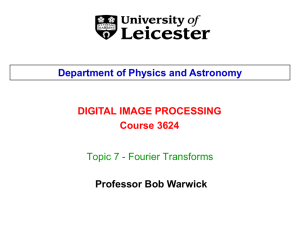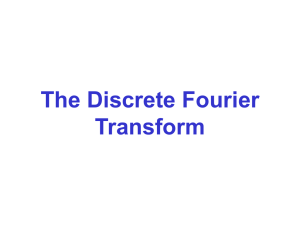Parallel linear solver for acoustics problems involving vibrating
advertisement

A Parallel Linear Solver for Block Circulant Linear Systems with Applications to Acoustics Suzanne Shontz, University of Kansas Ken Czuprynski, University of Iowa John Fahnline, Penn State EECS 739: Scientific Parallel Computing University of Kansas January 22, 2015 MOTIVATION Application: Vibrating Structures Immersed in Fluids Examples: Ships, UAVs, planes, blood pumps, reactors Examples of Rotationally Symmetric Boundary Surfaces Real-world applications: propellers, wind turbines, etcetera THE PROBLEM The Problem Goal: To compute the acoustic radiation for a vibrating structure immersed in a fluid. Our focus: Structures with rotationally symmetric boundary surfaces Image credit: Michael Lenz Parallel Linear Solver for Acoustic Problems with Rotationally Symmetric Boundary Surfaces Context: Vibrating structure immersed in fluid. Acoustic analysis using boundary element method. Coupled to a finite element method for the structural analysis. We focus on the boundary element part of the calculation. Goal: Solve block circulant linear systems to compute acoustic radiation of vibrating structure with rotationally symmetric boundary surface. Approach: Parallel linear solver for distributed memory machines based on known inversion formula for block circulant matrices. THE BOUNDARY ELEMENT METHOD (BEM) Boundary Element Method The boundary element method (BEM) is a numerical method for solving linear partial differential equations (PDEs). In particular, the BEM is a solution method for solving boundary value problems (BVPs) formulated using a boundary integral formulation. Discretization: Only of the surface (not of the volume). Reduces dimension of problem by one. BEM: Used on exterior domain problems and when greater accuracy is required. We employ the boundary element method to obtain the linear system of equations. Comparison of the BEM with the Finite Element Method Advantages of the BEM Disadvantages of the BEM Less data preparation time (due to surface only modeling) Unfamiliar mathematics High resolution of PDE solution (e.g., stress) The interior must be modeled for nonlinear problems (but can often be restricted to a region of the domain) Less computer time and storage (fewer nodes and elements) Fully populated and unsymmetric solution matrix (as opposed to being sparse and symmetric) Less unwanted information (most “interesting behavior” happens on the surface) Poor for thin structures (shell) 3D analyses (large surface/volume ratio causes inaccuracies in calculations) BLOCK CIRCULANT MATRICES VIA THE BOUNDARY ELEMENT METHOD Discretization Using the BEM rotationally symmetric boundary surface symmetry: m=4 block circulant matrix Block Circulant Matrices • Properties of circulant matrices: Diagonalizable by Fourier matrix. Can use DFT and IDFT. Nice properties! • Related work (serial): algorithm derived from inversion formula (Vescovo, 1997); derivation (Smyrlis and Karageorghis, 2006) • Related work (parallel): parallel block Toeplitz matrix solver (Alonso et al., 2005) (neglects potential concurrent calculations); parallel linear solver for axisymmetric case (Padiy and Neytcheva, 1997) MATHEMATICAL FORMULATION OF LINEAR SYSTEM OF EQUATIONS Notation: Fourier Matrix The Fourier matrix is given by where 𝜔m = 𝑒 𝑖2𝜋/𝑚 . Note: The Fourier matrix is used in Fourier transforms. Discrete Fourier Transform (DFT) To compute the discrete Fourier transform (DFT) of a vector x, simply multiply F times x. Example: m = 4 F*x = u Inverse Discrete Fourier Transform (IDFT) To compute the inverse of the discrete Fourier transform (IDFT) of a vector u, simply multiply 𝟏 F* times u, where F* = Hermitian of F. 𝒎 Continuing the example: - + + - Divide by m F* times u = m*x Fast Fourier Transform (FFT) The Fourier transform of a vector (i.e., the DFT of a vector) of length 2m can be computed quickly by taking advantage of the following relationship between Fm and F2m: 𝑭𝟐𝒎 𝑰 = 𝑰 𝑫 −𝑫 𝑭𝒎 𝟎 𝟎 P, 𝑭𝒎 where D is a diagonal matrix and P is a 2m by 2m permutation matrix. Fast Fourier Transform (FFT): Requires two size m Fourier transforms plus two very simple matrix multiplications! Key Equations Let F = Fourier matrix, and let Fb denote the Kronecker product of F with In. Then, the block DFT is given by: ~ X Fb To solve: where ~ ~ x F* x , b F* b b b. X SERIAL ALGORITHM Block Circulant Matrix: Storage Block Circulant Matrix: Size of Linear Systems Note: Solving a dense linear system is cubic in the size of the matrix. Sequential Algorithm IDFT DFT DFT Solution of m independent linear systems PARALLEL ALGORITHM How to Parallelize the Algorithm? Ideas? Recall, we are interested in solving m independent linear systems to solve! where ~ ~ x F* x , b F* b b b. Block DFT Algorithm • A block DFT calculation is the basis for our parallel algorithm. • This demonstrates improved robustness (over use of the FFT) and allows for any boundary surface to be input. DFT Computation This generalizes to the case when P > m. Parallel Algorithm Asynchronous sends and receives. Solve using SCALAPACK. Complexity: Cubic in n The tradeoff of using overlapped communication and computation is additional memory. NUMERICAL EXPERIMENTS Computer Architecture for Experiments Cyberstar compute cluster at Penn State: • Run on two Intel Xeon X5550 quad-core processors • HyperThreading = disabled • Total: 8 physical cores running at 2.66 GHz • 24 GB of RAM per node Code: • Fortran 90 with MPI • ScaLAPACK library Blocking and Communication: • Blocking factor of 50 for block cyclic distribution of Aj and bj onto their respective processor grids. • DFT algorithm communications: blocks of size 4000 • Asynchronous sends/receives Metrics for Experiments • Runtime = wall clock time of parallel algorithm = Tp • Speedup = how much faster is the parallel algorithm than the serial algorithm = S = Ts/Tp • Efficiency = E = S/P Experimental Results – 4 Processors The runtime decreases as the number of processors increase and as the problem size decreases. Oscillations are due to small variance in small runtime numbers. They are smoothed out with increasing N. The efficiency increases for a decreased number of processors. It also increases with an increase in problem size. Experimental Results – 8 Processors The runtime trend is the same as it is for m = 4. Experimental Results – 8 Processors For small problems, the speedup levels off due to the ratio of computation versus communication in the linear system solve. For larger problems, the speedup is nearly linear. Experimental Results – 8 Processors The efficiency is fairly good but not quite as high as it is for m = 4. Based on increase in communications due to DFT algorithm and size of linear system solve. Expect efficiency to remain high for increased problem size. CONCLUSIONS Conclusions • We have proposed a parallel algorithm for solution of block circulant linear systems. Arise from acoustic radiation problems with rotationally symmetric boundary surfaces. • Based on block DFTs (more robust) and have embarrassingly parallel nature based on ScaLAPACK’s required data distributions. • Reduced memory requirement by exploiting block circulant structure. • Achieved near linear speedup for varying problem size, linear speedup for large N. Efficiency increases with problem size. • Can solve larger/higher frequency acoustic radiation problems. Reference K.D. Czuprynski*, J. Fahnline, and S.M. Shontz, Parallel boundary element solutions of block circulant linear systems for acoustic radiation problems with rotationally symmetric boundary surfaces, Proc. of the Internoise 2012/ASME NCAD Meeting, August 2012. Acknowledgements This work is based on the M.S. Thesis of Ken Czuprynski in addition to our Internoise 2012 paper. Computing Infrastructure: • NSF grant OCI-0821527 Research Funding: • Penn State Applied research Laboratory’s Walker Assistantship Program (Czuprynski) • NSF Grant CNS-0720749 (Shontz) • NSF CAREER Award OCI-1054459 (Shontz)








